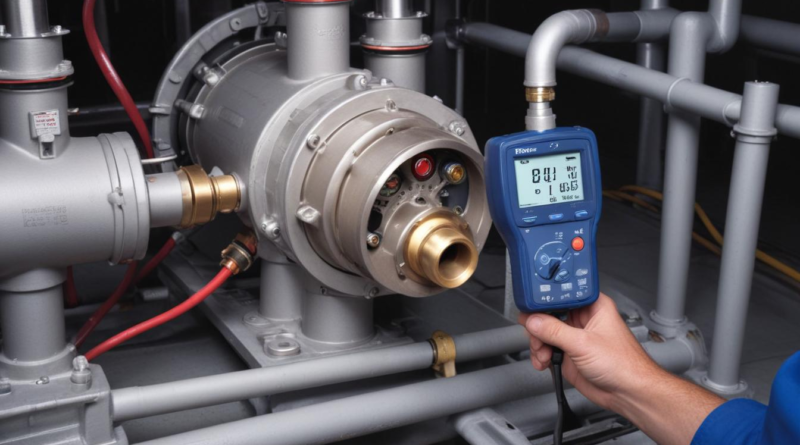how to perform pump thermal checks
Pump thermal monitoring is an essential component in ensuring the reliable and efficient operation of pumping systems. By systematically tracking the temperature of various pump components, maintenance teams can detect anomalies early, preventing potential failures and extending the lifespan of the equipment. Implementing effective thermal monitoring involves understanding the normal temperature ranges, recognizing deviation patterns, and integrating this data into regular maintenance procedures.
Key aspects of pump thermal monitoring include:
- Temperature Measurement: Utilizing sensors to continuously monitor the temperature of critical components such as bearings, seals, and motors.
- Data Analysis: Analyzing temperature trends to identify abnormal patterns that may indicate underlying issues.
- Alarm Systems: Setting up alert mechanisms to notify maintenance personnel when temperatures exceed predefined thresholds.
A structured approach to thermal monitoring can be illustrated in the following table:
| Component | Normal Temperature Range | Potential Issues |
|---|---|---|
| Bearings | 60°C – 80°C | Insufficient lubrication, misalignment, excessive load |
| Motor | 70°C – 90°C | Electrical faults, overloading, ventilation problems |
| Seal Area | 50°C – 70°C | Seal degradation, improper installation |
Implementing an effective thermal monitoring system involves several steps:
- Installation of Sensors: Place temperature sensors at critical points to gather accurate data.
- Baseline Establishment: Determine the normal operating temperature ranges for each component under standard conditions.
- Continuous Monitoring: Use data acquisition systems to track temperature changes in real-time.
- Data Interpretation: Analyze the collected data to identify trends and pinpoint potential issues.
- Maintenance Scheduling: Integrate thermal data into maintenance plans to perform timely interventions.
By incorporating pump thermal checks into regular maintenance routines, organizations can enhance the dependability of their pumping systems, reduce downtime, and optimize operational efficiency. Proper thermal monitoring not only helps in early detection of problems but also in making informed decisions regarding equipment replacement and upgrades.
necessary tools and equipment
Performing pump thermal checks requires a specific set of tools and equipment to ensure accurate measurements and reliable data collection. The selection of appropriate tools is crucial for effective thermal monitoring and subsequent maintenance procedures. The following list outlines the essential equipment needed:
- Infrared Thermometers: These are non-contact devices used to measure surface temperatures quickly and accurately. They are ideal for initial assessments and areas that are difficult to access.
- Thermocouples: These sensors provide precise temperature readings and can be integrated into data acquisition systems for continuous monitoring.
- Data Loggers: Devices that record temperature data over time, allowing for trend analysis and identification of abnormal temperature patterns.
- Thermal Imaging Cameras: Provide a visual representation of temperature distribution across the pump components, aiding in the identification of hot spots and potential failures.
- Calibration Equipment: Ensures that all temperature measurement devices are accurate and reliable by regularly checking and adjusting their accuracy.
- Personal Protective Equipment (PPE): Safety gear such as gloves and safety glasses to protect technicians during thermal checks.
- Mounting Hardware: Securely attaches sensors and cameras to pump components to maintain consistent and stable measurements.
Having the right tools is only part of the equation; proper preparation is essential to ensure effective pump thermal checks. This includes verifying that all equipment is calibrated, establishing baseline temperature readings, and setting up data acquisition systems for continuous monitoring.
The tools and equipment can be summarized in the table below:
| Tool/Equipment | Purpose | Key Features |
|---|---|---|
| Infrared Thermometers | Measure surface temperatures | Non-contact, quick readings, portable |
| Thermocouples | Provide precise temperature measurements | High accuracy, suitable for data integration |
| Data Loggers | Record temperature data over time | Continuous monitoring, trend analysis |
| Thermal Imaging Cameras | Visualize temperature distribution | Identify hot spots, comprehensive analysis |
| Calibration Equipment | Ensure measurement accuracy | Regular checks, maintain reliability |
| PPE | Protect technicians | Safety gloves, glasses |
| Mounting Hardware | Secure sensors and cameras | Stable measurements, durability |
In addition to the hardware, having the appropriate software is beneficial for data analysis and reporting. Software solutions can help automate the collection of temperature data, generate alerts for abnormal readings, and provide detailed reports that support maintenance decision-making. Integrating these tools into a comprehensive thermal monitoring system enhances the effectiveness of pump thermal checks and ensures that maintenance teams have the necessary information to maintain optimal pump performance.
preparing for the thermal check
Prior to initiating pump thermal checks, comprehensive preparation is paramount to ensure the accuracy and effectiveness of the procedures. Thorough preparation involves several critical steps that collectively establish a solid foundation for successful thermal analysis and subsequent maintenance activities.
Firstly, it is essential to review all relevant pump documentation. This includes operational manuals, maintenance records, and previous thermal monitoring data. Understanding the historical performance and any past issues provides context and aids in identifying trends or recurring problems. Additionally, verifying the manufacturer’s specifications for normal temperature ranges and operational parameters ensures that the thermal checks are aligned with the equipment’s design criteria.
Scheduling is another vital aspect of preparation. Coordinate with maintenance teams to allocate an appropriate time window for performing the thermal checks, preferably during periods of low operational demand or planned downtime. This minimizes the impact on overall system performance and allows technicians to conduct thorough inspections without time constraints.
Ensuring that all safety protocols are in place is crucial for protecting personnel and equipment. This involves:
- Lockout/Tagout (LOTO) Procedures: Implementing LOTO ensures that the pump is safely isolated from energy sources during the thermal checks.
- Personal Protective Equipment (PPE): Confirm that all technicians are equipped with the necessary PPE, such as gloves, safety glasses, and protective clothing.
- Safety Briefings: Conducting briefings to inform the team of the specific safety measures and emergency procedures related to the thermal check.
Before commencing the thermal analysis, verify that all tools and equipment are properly calibrated and in good working condition. Calibration ensures the accuracy of temperature measurements, which is critical for reliable data. Additionally, inspect sensor placement to confirm that temperature probes are correctly positioned on key components like bearings, motors, and seals to capture representative thermal data.
Establishing baseline measurements is essential for comparative analysis. Baselines represent the normal operating temperatures under standard conditions and serve as reference points for detecting anomalies. To create accurate baselines:
- Collect Initial Data: Record temperature readings during regular operations to understand typical thermal profiles.
- Analyze Variability: Assess the range and fluctuations in temperature to determine acceptable limits.
- Document Baselines: Maintain detailed records of baseline temperatures for ongoing comparison and trend analysis.
Coordination and communication with relevant personnel are also critical. Informing operators and maintenance staff about the scheduled thermal checks ensures that everyone is aware of the activities and can provide necessary support or adjustments to operations if required. Clear communication helps in mitigating any potential disruptions and facilitates a collaborative approach to maintenance.
Finally, conducting a pre-check inspection of the pump ensures that the equipment is in a suitable condition for thermal monitoring. This includes:
- Visual Inspection: Look for obvious signs of wear, damage, or leaks that could affect thermal readings.
- Operational Checks: Verify that the pump is functioning correctly and that there are no immediate issues that could skew the thermal data.
- Environmental Assessment: Ensure that the ambient conditions, such as airflow and temperature around the pump, are stable and controlled to avoid external factors influencing the measurements.
By meticulously preparing for pump thermal checks, maintenance teams can ensure that the thermal analysis is conducted efficiently and yields accurate, actionable data. Proper preparation not only enhances the reliability of the thermal monitoring process but also supports proactive maintenance strategies, ultimately contributing to the longevity and optimal performance of pumping systems.
conducting the thermal analysis
 To effectively perform the thermal analysis, it is crucial to follow a systematic approach that ensures accurate data collection and reliable interpretation. This process involves several key steps, each contributing to the overall integrity of the pump thermal checks.
To effectively perform the thermal analysis, it is crucial to follow a systematic approach that ensures accurate data collection and reliable interpretation. This process involves several key steps, each contributing to the overall integrity of the pump thermal checks.
Data Collection is the first critical phase. Utilizing the previously installed sensors and thermal imaging equipment, gather temperature readings from all designated points on the pump. Ensure that data is collected under consistent operational conditions to maintain the validity of the measurements. It is advisable to monitor the pump over a representative period, capturing variations during different operational states such as startup, steady-state operation, and shutdown.
During data collection, it is essential to monitor in real-time to promptly identify any immediate anomalies. Real-time monitoring allows for the detection of sudden temperature spikes that may indicate acute issues requiring immediate attention. Utilize data loggers and software interfaces to facilitate continuous tracking and ensure that no critical data points are missed.
Once sufficient data has been gathered, proceed with the data analysis phase. This involves comparing the collected temperatures against the established baseline measurements. An effective way to organize this comparison is through the use of tables and charts that highlight deviations from normal operating ranges.
| Component | Recorded Temperature | Baseline Temperature | Deviation | Potential Issue |
|---|---|---|---|---|
| Bearings | 85°C | 75°C | +10°C | Possible insufficient lubrication or overloading |
| Motor | 95°C | 85°C | +10°C | Electrical faults or inadequate ventilation |
| Seal Area | 72°C | 68°C | +4°C | Seal degradation |
Trend Analysis is another vital component of the thermal analysis. By examining temperature trends over time, maintenance teams can identify patterns that may not be immediately apparent from isolated data points. For instance, a gradual increase in bearing temperatures over several weeks could indicate developing issues such as wear or misalignment, allowing for proactive maintenance before a failure occurs.
Utilizing visualization tools such as thermal maps and trend graphs can enhance the understanding of temperature distribution and temporal changes. Thermal imaging cameras can create detailed visual representations, making it easier to pinpoint specific areas that consistently exhibit higher temperatures.
Threshold Settings play a significant role in automating the monitoring process. Establishing appropriate temperature thresholds based on manufacturer specifications and operational history ensures that alerts are generated only when necessary. This reduces the likelihood of false alarms and helps maintenance personnel focus on genuine issues. Thresholds should be regularly reviewed and adjusted as needed to reflect any changes in operating conditions or equipment upgrades.
Implementing these procedures requires a collaborative effort between maintenance teams and technical specialists. Effective communication ensures that all relevant data is accurately interpreted and that appropriate actions are taken promptly. Detailed documentation of the thermal analysis process and findings is essential for maintaining a comprehensive maintenance history and for informing future pump thermal checks.
By meticulously conducting the thermal analysis, organizations can leverage the full potential of pump thermal checks, ensuring the longevity and optimal performance of their pumping systems. This proactive approach not only minimizes downtime and maintenance costs but also enhances overall operational efficiency.
interpreting and documenting results
Once the thermal analysis is complete, the next critical step involves interpreting the collected data and effectively documenting the findings to inform maintenance decisions and ensure the continued reliability of the pump system. This process requires a comprehensive approach to analyze temperature readings, identify anomalies, and systematically record the results for future reference.
Data Interpretation begins with comparing the recorded temperatures against the established baseline measurements. This comparison helps in identifying any deviations that may indicate potential issues within the pump components. Key aspects of data interpretation include:
- Deviation Analysis: Assess the extent of temperature deviations from baseline values to determine their significance.
- Pattern Recognition: Identify recurring temperature trends that could signal gradual wear or emerging faults.
- Correlation with Operational Conditions: Consider the operating conditions during data collection to contextualize temperature changes.
Effective interpretation often involves categorizing the data to prioritize maintenance actions. The following table illustrates a structured approach to categorizing temperature deviations:
| Deviation Range | Severity | Recommended Action |
|---|---|---|
| Within ±5°C of Baseline | Normal | Continue regular monitoring. |
| +5°C to +10°C Above Baseline | Minor | Schedule a detailed inspection during the next maintenance cycle. |
| +10°C Above Baseline | Major | Immediate investigation and corrective actions required. |
| +15°C Above Baseline | Critical | Shutdown and perform urgent maintenance to prevent failure. |
Documentation of the results is essential for maintaining a historical record of the pump’s thermal performance and for facilitating informed maintenance decisions. Comprehensive documentation practices include:
- Detailed Reports: Create reports that include all temperature readings, baseline comparisons, identified deviations, and recommended actions. These reports should be clear, concise, and accessible to all relevant personnel.
- Visual Representations: Incorporate charts, graphs, and thermal images to visually depict temperature distributions and trends. Visualization aids in quicker comprehension and easier identification of problem areas.
- Maintenance Logs: Update maintenance logs with the findings from the thermal checks, including any actions taken to address identified issues. This ensures continuity and provides a reference for future thermal monitoring activities.
- Incident Records: Document any incidents where temperature deviations led to pump issues or failures. Analyzing these records can help in refining thermal monitoring procedures and preventive strategies.
The following table outlines a standardized format for documenting pump thermal check results:
| Date | Component | Recorded Temperature (°C) | Baseline Temperature (°C) | Deviation (°C) | Severity | Action Taken |
|---|---|---|---|---|---|---|
| 2024-04-01 | Bearings | 82 | 75 | +7 | Minor | Scheduled inspection for next month. |
| 2024-04-01 | Motor | 95 | 85 | +10 | Major | Initiated immediate maintenance. |
| 2024-04-01 | Seal Area | 72 | 68 | +4 | Normal | Continue regular monitoring. |
Trend Analysis is another crucial element in interpreting thermal check results. By examining data trends over multiple monitoring periods, maintenance teams can identify progressive changes that may not be evident in isolated readings. Tools such as trend graphs and moving averages can be employed to visualize these patterns, facilitating proactive maintenance measures. For example, a consistent upward trend in bearing temperatures may indicate gradual wear, prompting preemptive replacement before a critical failure occurs.
Reporting and Communication ensure that the insights gained from thermal checks are effectively shared with all stakeholders. Regularly scheduled meetings to review thermal monitoring reports can help in aligning maintenance strategies with operational goals. Additionally, integrating documentation into a centralized maintenance management system allows for easy access and analysis, supporting data-driven decision-making.
In summary, the process of interpreting and documenting pump thermal check results is integral to a successful thermal monitoring program. Accurate analysis and thorough documentation not only enable timely maintenance actions but also contribute to the overall reliability and efficiency of the pumping system.


